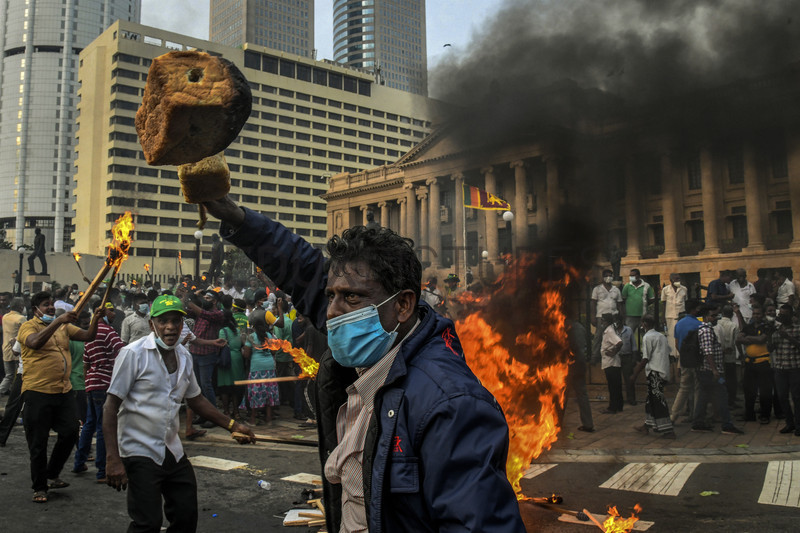This is the first edition of The Polycrisis newsletter, written by Kate Mackenzie and Tim Sahay. Subscribe here to get it in your inbox.
What crisis?
A year ago, one might be forgiven for thinking there was a moment of relative calm for wealthy countries: a year of vaccinations had made the pandemic less acute, inflation hadn’t yet provoked interest rate hikes, and labor markets were strong. In the climate world, the energy transition was progressing and, after years of struggle in the UN climate diplomacy track, there was even some sign from rich countries that the poorest and most vulnerable states might be compensated for the loss and damage from climate-fueled disasters.
In reality, all was not well. As anticipated early in the pandemic, dozens of low-income and smaller middle-income countries were continuing to grind towards sovereign debt crises provoked by a sudden drop in foreign income and climbing healthcare costs. Creditors (the wealthy Paris Club countries, multilateral banks, bondholders, and China) had all failed to head off this debt crisis. Meanwhile, vaccines remained unavailable to many people in the poorest countries. Energy costs were climbing.
Then Russia’s invasion of Ukraine, and historic coordinated economic sanctions by Western governments, made everything much worse—in ways that even the world’s richest countries couldn’t avoid.
Energy costs in Europe were already high going into the winter of 2021. This was driven in part by the curtailment of China’s coal-fired generation leading to more demand for imported gas. In 2022, it’s spilled over into other countries: Europe and richer east Asia countries are now in a bidding war for limited gas supplies. Others have been priced out of the market entirely. Pakistan had rolling weeks-long power outages; while gas rationing by Bangladesh was not enough to prevent a grid collapse earlier this month, leaving over a hundred million people to grapple with blackouts.
Last week, the IMF forecasted slowing global growth in 2023, and a “material worsening” of world financial stability. Havoc in the real world is pushing a financial crisis in wealthy economies, which in turn will exacerbate real suffering, as food and energy imports are pushed further out of reach of countries struggling to afford US-dollar denominated commodities.
In the background to all of this are increasingly frequent and severe weather disasters caused by a warming climate—and the urgent and persistent imperative to eliminate greenhouse gas emissions. Nature does not stay at home.
The climate crisis cannot be solved without a thorough reckoning of the relations between the global South and the global North. While the US enjoys primacy in the global financial architecture, and other wealthy countries have outsized influence, developing countries are not without agency. Middle-income powers were either excluded from or unenthusiastic about the G7’s early coordinated sanctions on Russia. They are now using strategic non-alignment—playing one bloc off another—to secure resources and industries, such as transition minerals and chips.
Global North countries seem unprepared for the economic and geopolitical agency being exercised by the big middle-income countries. Nor are they responding to smaller and poorer nations. The IMF’s new long term facility, the Resilience and Sustainability Trust, is meagre next to the needs of its target recipients: vulnerable countries battling with the pandemic and climate change. But those countries, too, are finding ways to be heard. In September, Barbados PM and recent chair of the World Bank/IMF Development Committee Mia Mottley released the “Bridgetown Agenda,” calling for debt reform, rechanneling of SDRs, and multilateral lending. (Mottley was the subject of a lengthy New York Times profile on how she obtained IMF support in restructuring the tiny country’s US dollar bonds to account for hurricane losses, while avoiding the IMF’s traditional austerity prescription.)
The Agenda calls for “urgent and decisive action” in the face of an “unprecedented combination of crises,” and will probably attract great interest at COP27 in Egypt next month. But it will have to contend with the vexed question of the $100 billion in climate finance previously promised for the global South, and the thorny issue of loss and damage. India and Indonesia—developing countries that have weathered recent shocks with relative resilience—are taking the helm at the G20. But the possibility of even modest progress in that forum is slim, with geopolitical tensions with Russia making the issuance of a communiqué unlikely.
Increasingly widespread appeals to the term “polycrisis” are not a get-out-of-of-jail-free card for powerful interests, who must make principled decisions amidst systemic crises. None of this will sort itself out.
The Polycrisis aims to untangle the Gordian Knot of security, climate, economic, and political dilemmas. Stay connected here, forward this first edition to three new readers to help us grow our audience, and write to us to continue the conversation.
Postscript: Why “The Polycrisis ?”
Over the last year, historian Adam Tooze popularized the term “polycrisis.” Previously deployed by Jean-Claude Juncker in to describe the eurozone-Brexit-climate-refugee crises in 2016, and originally attributed to French complexity theorist Edgar Morin, Tooze explored it again in June with his crisis pictures of overlapping emergencies—pandemic, sovereign debt, inflation, GOP risk, hunger—in which the whole becomes more dangerous than the sum of the parts.
We also want to acknowledge a debt to economic analyst Nathan Tankus, who articulated the interconnectedness that we want to track in our project, pointing out that his newsletter was called Notes on the Crises, “for the simple reason that this is not the only crisis we will encounter over the next several decades.”
Our goal is to explore those connections, and to identify and amplify others who are doing the same.
Email us to join the discussion.
Filed Under
